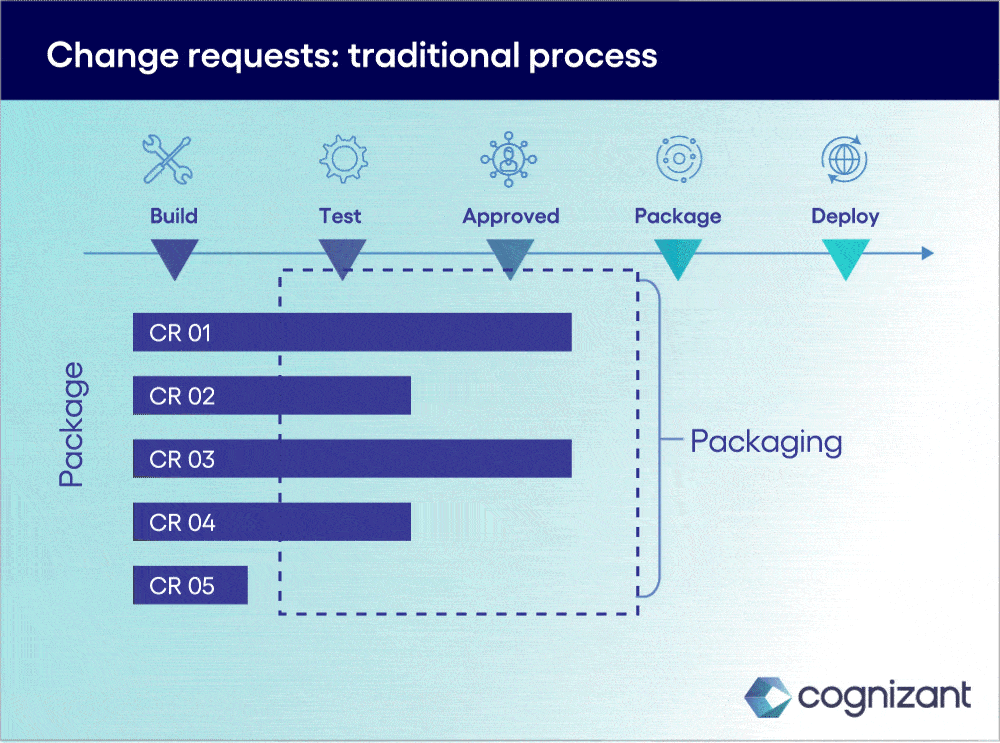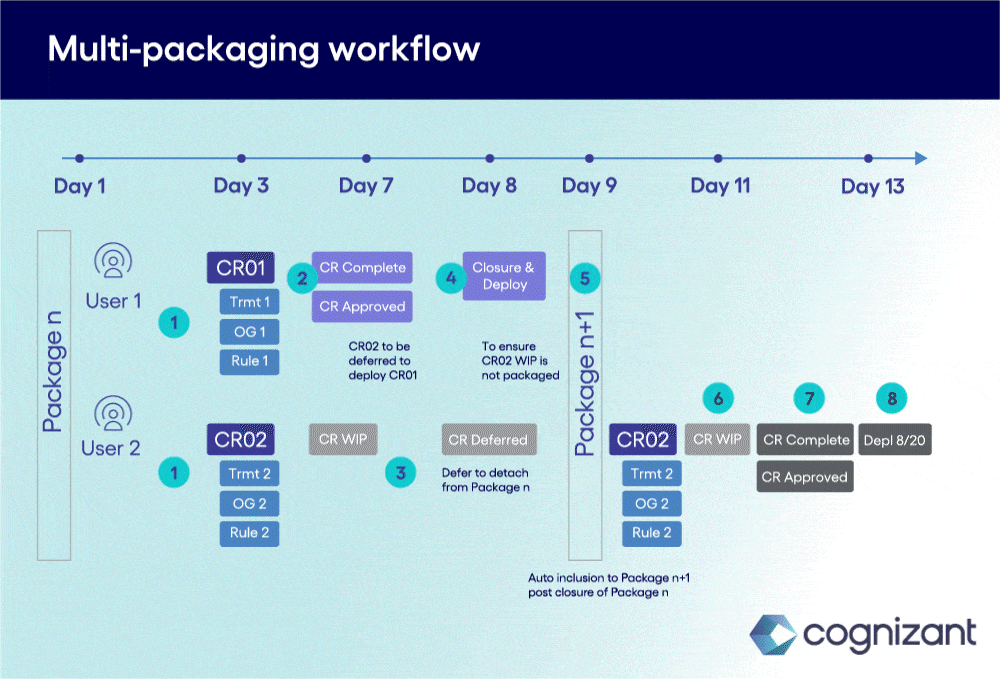June 21, 2023
Enabling concurrent changes for Marketing Ops
Speeding the offer pack process allows teams to meet the high expectations of today’s customers.
Customers’ demands for personalization and expectations for immediate service mean companies need to be able to quickly customize offer packs based on specific requirements. This has prompted many businesses to expand the capabilities of their Marketing Ops team to directly update an offer pack, instead of working with the IT function to make these changes.
But many of the low-code platforms used by Marketing Ops teams to manage this day-to-day activity have one significant shortcoming: They do not allow concurrent changes. This means different teams must coordinate when and how they update the offer pack, then wait for one another to complete their changes before the next group can start its work.
All this lengthens project timelines and slows time-to-market, making it harder to reach customers with relevant, timely offers—the very reason for enabling Marketing Ops to make changes to the offer pack in the first place.
Until recently, companies had limited options for enabling this capability without significant customization of their marketing platform. However, in this article, we share how companies can enable concurrent changes within Pega.
Why concurrent changes are needed
Marketing organizations—particularly those in the telecommunications, software-as-a-service, and financial services industries—have become more complex. For these businesses, it’s not uncommon to have two or three teams, each with its own unique objectives, working on multiple offer packs that align to the same business strategy.
However, even though these teams operate independently of one another, their offer packs are indelibly linked within the system. In other words, the offer is locked whenever one team is making a change, and those updates are linked to other change requests related to the offer pack. As such, changes made by one team can sometimes delay or derail other teams’ work.
Why concurrent changes are a challenge
Most of the systems used by Marketing Ops teams are simply not designed to support concurrent changes between two or more teams, even though this is a practical requirement in many businesses.
For example, one of the most common scenarios for marketing teams is the management of multiple release dates. In a modern Marketing Ops organization, there are routinely three or more different groups working on separate releases within the system at any given time.
In a traditional system, these three teams are organized under a single active canvas and follow the organization’s standard build-to-deploy lifecycle. When the first release team is ready to deploy, the system typically bundles any program elements across all release projects that were past a certain stage within the cycle (e.g., past the build stage) and deploy them to production unless the team manually deferred the rollbacks or worked sequentially.
In this scenario, the tool does not have the logic to un-tag work from later releases that is still in progress, which means work that is untested or unapproved is bundled with the release cycle and may inadvertently be deployed. To prevent this from happening, the team must manually roll back these change requests (CRs) from future releases, which leads to rework and increases the risk of errors.
Figure 1 illustrates how the traditional process compiles and bundles CR 01 to 04 in the first release since they are all past the build stage.
Figure 1
How to equip the business with the ability to make concurrent changes
Marketing organizations need a way to segregate both the case data and the rule data for releases within the system. Doing so gives teams the ability to package approved CRs and leave in-progress requests that aren’t ready for production for a future release cycle.
For example, in our earlier scenario, if two or more CRs were initiated under the current active package by different marketers, only the CR that is approved and ready to be deployed will be pushed to production. Other in-progress CRs, even if they’re past the build stage, will be orphaned and auto-tagged to the next package. The entire process is executed automatically, and the respective marketers can continue to work through the lifecycle of the in-progress CRs without disruptions to their process or data.
This capability gives teams more flexibility to create multi-packaging workflows. For example, in Figure 2, if CR01 gets withdrawn on Day 7, it can continue to be in the same Package N and follow the process to deployment. If CR02 starts on Day 2, it will be auto-linked to Package N and thus deferred to a later release, even though it is in progress during the first release.
In this system, if a CR is approved and then deferred, the same CR must be reapproved once the deferred one is reinitiated.
Figure 2
In using a platform this way, Marketing Ops teams gain several new capabilities:
- The ability to work on multiple packages simultaneously.
- The ability to manage parallel work streams and deployment processes for multiple packages.
- The ability to detach a CR at any stage if it is not ready for deployment, while also preserving the orphaned CR data to avoid repeat configuration when reattaching to the next active revision.
Benefits of concurrent change
By enabling concurrent change, Marketing Ops teams unlock several benefits:
- Flexibility. The new process enables teams to not only work simultaneously, but also to perform several new actions, such as detaching a CR from a bundle at any stage.
- Scalability. Because changes can be made concurrently, Marketing Ops teams can increase the number of packages and updates to the offer pack—while maintaining the highest level of speed.
- Time-to-market. Individual teams can work in tandem without waiting for one another to complete their changes before the next phase of work begins. This improves overall time-to-market, which helps the company hit all-important customer acquisition and retention numbers.
Best practices for enabling concurrent changes
Enabling concurrent change isn’t simply a technical configuration; it also requires evolution to existing business processes and adapted ways of working for people in the organization. Here are three key considerations organizations should include in their transformation plan when building a concurrent change function.
- Align business processes to enable concurrent changes. Working concurrently will be a new experience for many organizations. As a result, they must adapt and align business processes to reflect this new capability. Part of the change management exercise should include mapping new workflows from end to end and determining what peripheral processes are involved and how they can be adapted to optimize this new capability.
- Train and enable the marketing organization to use the system effectively. The solution outlined above is built on the Pega platform and utilizes its 1:1 Operations Manager and Customer Decision Hub. Teams must be skilled in using this platform and accompanying toolset. Beyond that basic capability, teams will need to be trained to work in parallel. This requires the organization to create an environment in which teams can test use cases and understand how they should adjust existing workflows based on the new and expanded functionalities of this solution.
- Set up reporting and dashboarding capabilities so that leaders can measure progress and introduce options for improvement. Because many different teams will be using the system, it’s important to set up a centralized dashboard to understand where each team, as well as each change request, is in the overall process. This helps the team optimize planning, as well as pinpoint areas of improvement.
The power of concurrent change is open to your Marketing Ops team
By enabling concurrent changes, Marketing Ops organizations can function simultaneously, which means they can work more efficiently, and therefore complete projects more quickly. This ability can help reduce time-to-market, which translates into stronger customer acquisition and retention numbers, as well as stronger growth and profitability.
For Marketing Ops teams, enabling concurrent change is a reality—and for many the key to a strong future.
To learn more, visit the Pega Software Services section of our website or contact us.
This article was written by Victor Roy and Narayan Lakshmanan, Pega Consultants in Cognizant’s Enterprise Platform Services practice.
We’re here to offer you practical and unique solutions to today’s most pressing technology challenges. Across industries and markets, get inspired today for success tomorrow.
Latest posts
Related posts
Subscribe for more and stay relevant
The Modern Business newsletter delivers monthly insights to help your business adapt, evolve, and respond—as if on intuition



